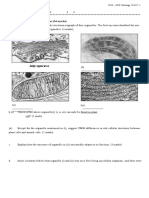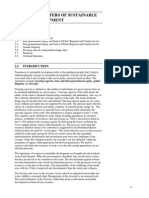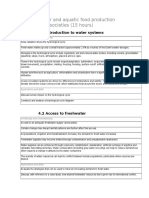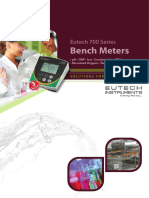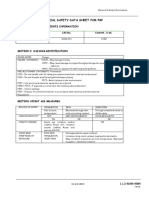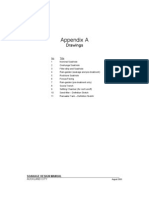Topic 8: Human Systems and Resource Use (16 Hours)
Topic 8: Human Systems and Resource Use (16 Hours)
Uploaded by
Michael SmithCopyright:
Available Formats
Topic 8: Human Systems and Resource Use (16 Hours)
Topic 8: Human Systems and Resource Use (16 Hours)
Uploaded by
Michael SmithOriginal Description:
Original Title
Copyright
Available Formats
Share this document
Did you find this document useful?
Is this content inappropriate?
Copyright:
Available Formats
Topic 8: Human Systems and Resource Use (16 Hours)
Topic 8: Human Systems and Resource Use (16 Hours)
Uploaded by
Michael SmithCopyright:
Available Formats
Topic 8: Human systems and resource use (16
hours)
8.1 Human population dynamics
Knowledge and Understanding
Demographic tools for quantifying human population include crude birth rate (CBR), crude death rate (CDR), total
fertility rate (TFR), doubling time (DT) and natural increase rate (NIR).
Global human population has followed a rapid growth curve, but there is uncertainty as to how this may be changing.
As the human population grows, increased stress is placed on all of the Earths systems.
Agegender pyramids and demographic transition models (DTM) can be useful in the prediction of human population
growth. The DTM is a model that shows how a population transitions from a pre-industrial stage with high CBRs and
CDRs to an economically advanced stage with low or declining CBRs and low CDRs.
Influences on human population dynamics include cultural, historical, religious, social, political and economic factors.
National and international development policies may also have an impact on human population dynamics.
Applications and skills
Calculate values of CBR, CDR, TFR, DT and NIR.
Explain the relative values of CBR, CDR, TFR, DT and NIR.
Analyse agegender pyramids and diagrams showing demographic transition models.
Discuss the use of models in predicting the growth of human populations.
Explain the nature and implications of growth in human populations.
Analyse the impact that national and international development policies can have on
human population dynamics and growth.
Discuss the cultural, historical, religious, social, political and economic factors that
influence human population dynamics.
8.2 Resource use in society
Knowledge and Understanding
Renewable natural capital can be generated and/or replaced as fast as it is being used. It includes living species and
ecosystems that use solar energy and photosynthesis, as well as non-living items, such as groundwater and the
ozone layer.
Non-renewable natural capital is either irreplaceable or can only be replaced over geological timescales; for example,
fossil fuels, soil and minerals.
Renewable natural capital can be utilized sustainably or unsustainably. If renewable natural capital is used beyond its
natural income this use becomes. The impacts of extraction, transport and processing of a renewable natural capital
may cause damage, making this natural capital unsustainable.
Natural capital provides goods (such as tangible products) and services (such as climate regulation) that have value.
This value may be aesthetic, cultural, economic, environmental, ethical, intrinsic, social, spiritual or technological.
The concept of a natural capital is dynamic. Whether or not something has the status of natural capital, and the
marketable value of that capital varies regionally and over time and is influenced by cultural, social, economic,
environmental, technological and political factors. Examples include cork, uranium and lithium.
Applications and skills
Outline an example of how renewable and non-renewable natural capital has been mismanaged.
Explain the dynamic nature of the concept of natural capital.
8.3 Solid domestic Waste
Knowledge and Understanding
There are different types of SDW, the volume and composition of which changes over time.
The abundance and prevalence of non-biodegradable pollution (such as plastic, batteries or e-waste) in particular has
become a major environmental issue.
Waste disposal options include landfills, incineration, recycling and composting.
There are a variety of strategies that can be used to manage SDW (refer to figure 3) influenced by cultural, economic,
technological and political barriers. These strategies include:
altering human activityfor example, through a reduction of consumption and composting of food waste.
controlling the release of pollutantgovernments create legislation to encourage recycling and reuse
initiatives and impose taxes for SDW collection and on disposable items
reclaiming landfills, using SDW for waste-to-energy programmes,
implementing initiatives to remove plastics from the Great Pacific Garbage Patch (clean-up and restoration).
Applications and skills
Evaluate SDW disposal options.
Compare and contrast pollution management strategies for SDW.
Evaluate, with reference to figure 3, pollution management strategies for SDW by considering recycling, incineration,
composting and landfills.
8.4 Human population carrying capacity
Knowledge and Understanding
Carrying capacity is the maximum number of a species, or load, that can be sustainably supported by a given area.
It is possible to estimate the carrying capacity of an environment for a given species; however, this is problematic in
the case of human populations for a number of reasons.
An EF is the area of land and water required to support a defined human population at a given standard of living. The
measure of an EF takes into account the area required to provide all the resources needed by the population, and the
assimilation of all wastes.
EF is a model used to estimate the demands that human populations place on the environment.
EFs may vary significantly by country and by individual and include aspects such as lifestyle choices (EVS),
productivity of food production systems, land use and industry. If the EF of a human population is greater than the
land area available to it, this indicates that the population is unsustainable and exceeds the carrying capacity of that
area.
Degradation of the environment, together with the consumption of finite resources, is expected to limit human
population growth.
If human populations do not live sustainably, they will exceed carrying capacity and risk collapse.
Applications and skills
Evaluate the application of carrying capacity to local and global human populations.
Compare and contrast the differences in the EF of two countries.
Evaluate how EVSs impact the EFs of individuals or populations.
You might also like
- Inside Out WorksheetDocument4 pagesInside Out WorksheetMichael Smith88% (8)
- Chapter 1 Review Questions KeyDocument18 pagesChapter 1 Review Questions KeyJade RanteNo ratings yet
- Research Proposal On Sustainable ConsumptionDocument12 pagesResearch Proposal On Sustainable ConsumptionSaadgi AgarwalNo ratings yet
- Sustainable DevelopmentDocument23 pagesSustainable DevelopmentUmairah Zeeshan100% (1)
- Twelve Angry Men WorksheetDocument1 pageTwelve Angry Men WorksheetMichael SmithNo ratings yet
- Useless Knowledge PDFDocument9 pagesUseless Knowledge PDFMichael Smith100% (1)
- Case Study - The Great Barrier ReefDocument3 pagesCase Study - The Great Barrier ReefMichael Smith100% (1)
- Report On Water PollutionDocument20 pagesReport On Water Pollutiondeepak202002tNo ratings yet
- McShane CdnOB10 IM11Document23 pagesMcShane CdnOB10 IM11Jessica LiuNo ratings yet
- Managing Service and Manufacturing OperationsDocument17 pagesManaging Service and Manufacturing OperationsAlvito Raihan MuhammadNo ratings yet
- McShane CdnOB10 IM08Document30 pagesMcShane CdnOB10 IM08Jessica LiuNo ratings yet
- Food Security WorksheetDocument9 pagesFood Security WorksheetTiffany KolbertNo ratings yet
- Pastel Gradient Modern Startup Pitch Deck PresentationDocument11 pagesPastel Gradient Modern Startup Pitch Deck PresentationAmalia HafshaNo ratings yet
- 4371334585jul2024 2Document7 pages4371334585jul2024 2adicakrajayakontraktorNo ratings yet
- The Influence of Islam On Medieval Europe (William Montgomery Watt) (Z-Library)Document134 pagesThe Influence of Islam On Medieval Europe (William Montgomery Watt) (Z-Library)Francesco SmeshNo ratings yet
- Repatriasi 20 Quarantine Hotels (Jakarta)Document1 pageRepatriasi 20 Quarantine Hotels (Jakarta)Andrian WicaksonoNo ratings yet
- Tourism & Sunda Traditional Architecture Perspective Between Issue, Problems, and Solution in Ciletuh Palabuhanratu Geopark, Sukabumi Regency, West JavaDocument40 pagesTourism & Sunda Traditional Architecture Perspective Between Issue, Problems, and Solution in Ciletuh Palabuhanratu Geopark, Sukabumi Regency, West JavaFARAH AIDA ILMIATUL KULSUMNo ratings yet
- OB Instructor's Resource - FinalDocument97 pagesOB Instructor's Resource - FinalMuznah DaudNo ratings yet
- Rubrics For DebateDocument1 pageRubrics For DebateLoida TagsipNo ratings yet
- Mar 2024Document3 pagesMar 2024kkpmpdkijakartaNo ratings yet
- OB14Document2 pagesOB14siliNo ratings yet
- Kerja Sama Indonesia Dengan AmerikaDocument20 pagesKerja Sama Indonesia Dengan AmerikarantojarkNo ratings yet
- Suspension TraumaDocument9 pagesSuspension TraumaLuthfy Kharisma Anggari100% (1)
- Biology Question Answer Book Name: Class: SECTION B. Structural Questions (54 Marks)Document6 pagesBiology Question Answer Book Name: Class: SECTION B. Structural Questions (54 Marks)Chun Kit LauNo ratings yet
- UNIT-V Sustainable DevelopmentDocument37 pagesUNIT-V Sustainable DevelopmentYaramadhi mohanalaxmiNo ratings yet
- Enviromental Footprint WordDocument11 pagesEnviromental Footprint WordFana TekleNo ratings yet
- EnvironmentDocument9 pagesEnvironmentshaheena.p999No ratings yet
- NREE Chapter Two-1Document12 pagesNREE Chapter Two-1SamNo ratings yet
- Block 1 MEC 008 Unit 3Document9 pagesBlock 1 MEC 008 Unit 3Adarsh Kumar GuptaNo ratings yet
- Local Media7836383884627581088Document6 pagesLocal Media7836383884627581088russeldabon24No ratings yet
- PG 2 Sem Population - Resource RelationshipDocument9 pagesPG 2 Sem Population - Resource RelationshipyusufNo ratings yet
- People and The Planet - Royal SocietyDocument8 pagesPeople and The Planet - Royal SocietyYuhong HeNo ratings yet
- UNIT4Readingmaterial.docxDocument15 pagesUNIT4Readingmaterial.docxtejasnaik7030No ratings yet
- Lecture Unit 2: 2. Big Issues of Our World Impacting Sustainability/sustainable DevelopmentDocument20 pagesLecture Unit 2: 2. Big Issues of Our World Impacting Sustainability/sustainable DevelopmentkronixserrNo ratings yet
- Our Common FutureDocument3 pagesOur Common FutureMarialena KonstantinidouNo ratings yet
- UN - Towards Sustainable DevelopmentDocument17 pagesUN - Towards Sustainable Developmentviva_33No ratings yet
- Ecological Footprint BasicsDocument15 pagesEcological Footprint BasicsAbigailNo ratings yet
- Complexity of Consumption and LifestyleDocument23 pagesComplexity of Consumption and LifestyleSudhanshu KumarNo ratings yet
- Individual Project Submitted To Mr. Pouya Zargar in Partial Fulfilment of The Requirements For The CourseDocument14 pagesIndividual Project Submitted To Mr. Pouya Zargar in Partial Fulfilment of The Requirements For The CoursedivineNo ratings yet
- LESSON 1 Environment and SustainabilityDocument36 pagesLESSON 1 Environment and SustainabilityMarygrace SanopalNo ratings yet
- APES Chapter 1Document8 pagesAPES Chapter 1testaccount10100% (1)
- B.Tech ECE UNIT I&IIDocument33 pagesB.Tech ECE UNIT I&IIShivam PatelNo ratings yet
- Urban Ecology Australia - Do We Fit On The PlanetDocument9 pagesUrban Ecology Australia - Do We Fit On The PlanetRique BenitesNo ratings yet
- Unit-2 Parameters of Sustainable Development PDFDocument12 pagesUnit-2 Parameters of Sustainable Development PDFNavdeep SinghNo ratings yet
- International Journal of Asian Social Science, 2013, 3 (3) :741-761Document21 pagesInternational Journal of Asian Social Science, 2013, 3 (3) :741-761Ahmad HaziqNo ratings yet
- Finals-Chapter 2Document5 pagesFinals-Chapter 2NICOLE CUDIAMATNo ratings yet
- Notes MED2Document91 pagesNotes MED2mailyjain.21No ratings yet
- Ess 3Document25 pagesEss 3Apollonia VitelliNo ratings yet
- Assaignment For ENV 501Document6 pagesAssaignment For ENV 501sarwar jahanNo ratings yet
- New Microsoft Word DocumentDocument35 pagesNew Microsoft Word DocumentS M Tayzul Islam100% (1)
- Biodiversity, Ecosystemservicesandhuman Welfare:aneconomist'sresponsetotackling GlobalbiodiversitylossDocument4 pagesBiodiversity, Ecosystemservicesandhuman Welfare:aneconomist'sresponsetotackling GlobalbiodiversitylossDeba SahooNo ratings yet
- 00 Circular - Economy - Resources - and - Environme PDFDocument15 pages00 Circular - Economy - Resources - and - Environme PDFИлья КорсунNo ratings yet
- Unit 1 (Part-1)Document25 pagesUnit 1 (Part-1)Avner ɸNo ratings yet
- Uy, Aljan Auie C. Define The Following, Climate Change: WeatherDocument4 pagesUy, Aljan Auie C. Define The Following, Climate Change: WeatherMartin NardoNo ratings yet
- Brundtland ReportDocument18 pagesBrundtland Reportveronlake100% (1)
- Ginno Jhep Acas Pacquing InstructorDocument11 pagesGinno Jhep Acas Pacquing InstructorJoshua RogadorNo ratings yet
- EVS Chap 01Document60 pagesEVS Chap 01krmayur22No ratings yet
- Blue Planet Synthesis Paper For UNEPDocument23 pagesBlue Planet Synthesis Paper For UNEPThe Guardian100% (2)
- Pages from David A. Anderson - Environmental economics and natural resource management-Routledge (2014)Document8 pagesPages from David A. Anderson - Environmental economics and natural resource management-Routledge (2014)lslamic StudioNo ratings yet
- Our Common FutureDocument18 pagesOur Common FutureMuhammad Hasnain MollahNo ratings yet
- Effect of Population On Environment-Case Study-NitcDocument53 pagesEffect of Population On Environment-Case Study-Nitcppv6nitc100% (1)
- Our Common Future, Chapt.Document19 pagesOur Common Future, Chapt.sidangel0No ratings yet
- Sustainable DevelopmentDocument26 pagesSustainable Developmentanimaile02No ratings yet
- evs3Document2 pagesevs3harshagarwalfocusjeeNo ratings yet
- SPA Sustainability NotesDocument94 pagesSPA Sustainability NotesSabari Vishnu KumarNo ratings yet
- Sample RLS - KQ Pairs (Updated)Document5 pagesSample RLS - KQ Pairs (Updated)Michael SmithNo ratings yet
- Sustainable FashionDocument4 pagesSustainable FashionMichael SmithNo ratings yet
- Why Soil Is DisappearingDocument9 pagesWhy Soil Is DisappearingMichael SmithNo ratings yet
- How Do We Know?Document7 pagesHow Do We Know?Michael Smith100% (2)
- Fisheries and OceansDocument2 pagesFisheries and OceansMichael SmithNo ratings yet
- Ecological Footprint by CountryDocument8 pagesEcological Footprint by CountryMichael SmithNo ratings yet
- Climate Crisis in BangladeshDocument8 pagesClimate Crisis in BangladeshMichael Smith100% (1)
- Exemplar TOK Essay May 2018Document8 pagesExemplar TOK Essay May 2018Michael SmithNo ratings yet
- TOK Sample Essay 1Document6 pagesTOK Sample Essay 1Michael SmithNo ratings yet
- The Placebo Effect's Role in HealingDocument5 pagesThe Placebo Effect's Role in HealingMichael SmithNo ratings yet
- TOK Sample Essay 1Document6 pagesTOK Sample Essay 1Michael SmithNo ratings yet
- Case Study Requirements For ESSDocument1 pageCase Study Requirements For ESSMichael SmithNo ratings yet
- Environmental Systems & SocietiesDocument70 pagesEnvironmental Systems & SocietiesMichael Smith100% (1)
- Imagination Is A Powerful ToolDocument3 pagesImagination Is A Powerful ToolMichael SmithNo ratings yet
- Environmental Impact AssessmentDocument2 pagesEnvironmental Impact AssessmentMichael SmithNo ratings yet
- TOK Sample Essay 2Document4 pagesTOK Sample Essay 2Michael SmithNo ratings yet
- Inside Out WorksheetDocument4 pagesInside Out WorksheetMichael SmithNo ratings yet
- Art and ArtistDocument6 pagesArt and ArtistMichael SmithNo ratings yet
- Topic 7: Climate Change and Energy Production (13 Hours)Document3 pagesTopic 7: Climate Change and Energy Production (13 Hours)Michael SmithNo ratings yet
- Imagination Is A Powerful ToolDocument3 pagesImagination Is A Powerful ToolMichael SmithNo ratings yet
- Summary From Ess Guide Topic 5Document3 pagesSummary From Ess Guide Topic 5Michael SmithNo ratings yet
- ESS Internal AssessmentDocument6 pagesESS Internal AssessmentMichael SmithNo ratings yet
- Topic 4 IB GuideDocument3 pagesTopic 4 IB GuideMichael SmithNo ratings yet
- Topic 6: Atmospheric Systems and Societies (10 Hours) : 6.1 Introduction To The AtmosphereDocument4 pagesTopic 6: Atmospheric Systems and Societies (10 Hours) : 6.1 Introduction To The AtmosphereMichael SmithNo ratings yet
- Millennium Ecosystem AssessmentDocument1 pageMillennium Ecosystem AssessmentMichael SmithNo ratings yet
- Topic 3 IB GuideDocument4 pagesTopic 3 IB GuideMichael SmithNo ratings yet
- 4.1 Basic Concepts of Population Dynamics.Document5 pages4.1 Basic Concepts of Population Dynamics.Hamidou Djire100% (2)
- Essay On Challenges of Food Security in Pacific NationDocument7 pagesEssay On Challenges of Food Security in Pacific NationtualaNo ratings yet
- SICEC EngineeringDocument17 pagesSICEC EngineeringvelathenggNo ratings yet
- Summit County Safe Passages For Wildlife Executive SummaryDocument2 pagesSummit County Safe Passages For Wildlife Executive SummaryEmilyNo ratings yet
- Thesis ProposalDocument29 pagesThesis ProposalGilbert Mendoza100% (1)
- Final Literature ReviewDocument8 pagesFinal Literature Reviewapi-508681193No ratings yet
- Water Supply Use and ManagementDocument39 pagesWater Supply Use and ManagementRoxette RoseteNo ratings yet
- Timesheet KBL July 2022 SalmanDocument29 pagesTimesheet KBL July 2022 SalmanSalman TamboliNo ratings yet
- Determination of Turbidity Exp No: 2 Date AimDocument3 pagesDetermination of Turbidity Exp No: 2 Date Aimkuthappady100% (1)
- F3 Deserts Exercise 2018-2019 (With Answers)Document5 pagesF3 Deserts Exercise 2018-2019 (With Answers)jonas hoNo ratings yet
- Chapter 8: Emergency Response Plan: 8.1 List of Likely EmergenciesDocument34 pagesChapter 8: Emergency Response Plan: 8.1 List of Likely Emergenciesaliff suhaimiNo ratings yet
- Climate Change Effect The Hydrological CycleDocument3 pagesClimate Change Effect The Hydrological Cyclealisa naziraNo ratings yet
- AGE525 Course Schedule Course Code: Course Title:: View FileDocument1 pageAGE525 Course Schedule Course Code: Course Title:: View FileBaliramBhosleNo ratings yet
- Science of The Total Environment: Yuanhong Hu, David Lindo-AtichatiDocument6 pagesScience of The Total Environment: Yuanhong Hu, David Lindo-Atichatimanuel ronaldNo ratings yet
- Toilet Matrix - 19102013Document10 pagesToilet Matrix - 19102013balakrishnagallaNo ratings yet
- n19 Grey WaterDocument2 pagesn19 Grey WaterJames CKNo ratings yet
- Microsoft Powerpoint - Technical Presentation On Bio-TowersDocument19 pagesMicrosoft Powerpoint - Technical Presentation On Bio-TowersbathalapalliNo ratings yet
- Dwa-M 381eDocument37 pagesDwa-M 381eMarko100% (2)
- UploadDocument34 pagesUploadKimi DeolNo ratings yet
- Pethiyagoda and Manamendra-Arachchi. 2012. Amphibians in Primary and Secondary Forest (Richness, Abundance, Species Table)Document8 pagesPethiyagoda and Manamendra-Arachchi. 2012. Amphibians in Primary and Secondary Forest (Richness, Abundance, Species Table)Alejandra CardonaNo ratings yet
- Esl English Printables For ReadingDocument3 pagesEsl English Printables For ReadingLahcen Ayoub100% (1)
- Bench Meters: Eutech 700 SeriesDocument8 pagesBench Meters: Eutech 700 SerieslinetreatmentNo ratings yet
- Material Safety Data Sheet For FRF: Component Cas No. Content, % WTDocument16 pagesMaterial Safety Data Sheet For FRF: Component Cas No. Content, % WTDamanpreet SinghNo ratings yet
- Field Visit Report (02-Dec-2020)Document5 pagesField Visit Report (02-Dec-2020)Ijaz AhmadNo ratings yet
- Relationship of Population and Natural ResourcesDocument2 pagesRelationship of Population and Natural ResourcesdarthlucasxNo ratings yet
- Air BindingDocument8 pagesAir BindingRishabh SethiNo ratings yet
- Lesson Plan Inquiry 7th Grade ScienceDocument2 pagesLesson Plan Inquiry 7th Grade Scienceapi-316973807No ratings yet
- New Zealand Soakage Design Manual - Auckland CityDocument11 pagesNew Zealand Soakage Design Manual - Auckland CityFree Rain Garden ManualsNo ratings yet
- Lengua Extranjera IngleesDocument2 pagesLengua Extranjera IngleesnicarenNo ratings yet























